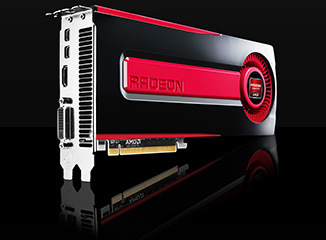 234
234
HD 7970: Bulldozer vs. Sandy Bridge vs. Nehalem Review
Test Setup »Introduction
Just one week ago AMD released their new Radeon HD 7970 graphics cards which introduced a new shader architecture and a new manufacturing process. The company's new flagship is the fastest single GPU graphics card in the world, and reviews across the Internet were generally favourable. Today, we test the Radeon HD 7970's CPU scaling, pitting AMD's recently released Bulldozer-based FX-8150 CPU against two formidable Intel opponents.According to the reviews online, AMD's latest processor architecture delivers surprisingly underwhelming performance, which quickly made it one of the biggest disappointments of the year according to some users. Loyal fanboys despise terms like "Faildozer" and have kept faith in AMD's promise to deliver a competitive high-end gaming capable processor.
Despite disappointing reviews, Bulldozer has gone on to sell quite well and has amassed a certain cult following with enthusiasts who would like to own this CPU regardless of benchmarks. Their purchasing reasons range from supporting the underdog, to setting records with its impressive overclocking abilities (8 GHz+ on LN2) and everything in-between. This has led some of these enthusiasts to clamour for a review of AMD's best in GPUs (Radeon HD 7970) and CPUs (FX-8150) to be compared working together against the Intel CPU competition to see just how well they do, as this seems to present an unknown variable in many end-users' buying decision.
In this review we will pit three CPUs from the popular ~$250 segment against each other using the Radeon HD 7970:
- AMD FX-8150: This is the company's current flagship Bulldozer processor. It features four execution units that show up as eight cores in Windows, its Turbo clocks up to 4.2 GHz and it has plenty of cache, the processor is priced competitively at $270.
- Intel Core i5-2500K: The processor most gamers and overclockers use. Thanks to its "K" suffix it enables significant overclocking unlike the cheaper Sandy Bridge processors, yet comes at an affordable price of $220. Actually this makes it the cheapest processor in today's test group.
- Intel Core i7-920: While it does not use a sexy 32 nm production process and is based on Intel's last generation Nehalem architecture, it still packs a punch especially when overclocked. It is also an affordable choice if you are looking to run a multi-GPU gaming rig at full 2x PCIe x16 without breaking the bank (LGA 2011).

| AMD FX-8150 | Intel Core i7-920 | Intel Core i5-2500K | |
|---|---|---|---|
| Number of Cores | 8 | 4 (8 threads) | 4 |
| Core Codename | Zambezi | Bloomfield | Sandy Bridge |
| Socket | AM3+ | LGA 1366 | LGA 1155 |
| Core Speed | 3.6 GHz | 2.67 GHz | 3.30 GHz |
| Turbo Boost | up to 4.2 GHz | up to 2.93 GHz | up to 3.7 GHz |
| L2 Cache | 4x 2048 KB | 4x 256 KB | 4x 256 KB |
| L3 Cache | 8 MB | 8 MB | 6 MB |
| Process Size | 32 nm | 45 nm | 32 nm |
| Die size | 315 mm² | 263 mm² | 216 mm² |
| TDP | 125 W | 130 W | 95 W |
| Price | $270 | $270 | $220 |
Apr 1st, 2025 18:43 EDT
change timezone
Latest GPU Drivers
New Forum Posts
- RTX 3090 is still a good card? (18)
- Is RX 9070 VRAM temperature regular value or hotspot? (282)
- Post your cooling. (196)
- Wondering if I can keep the same cooler.. (1)
- Can you guess Which game it is? (55)
- lowering the voltage but performance decreased a lot. (6)
- Is the futureproof gaming solution a four drive system? (36)
- Asus Rampage IV Formula Bios MOD (NVME Support + Resizable BAR) (0)
- What do you do for a living? (473)
- Question about Intel Optane SSDs (59)
Popular Reviews
- DDR5 CUDIMM Explained & Benched - The New Memory Standard
- Sapphire Radeon RX 9070 XT Pulse Review
- ASRock Phantom Gaming B850 Riptide Wi-Fi Review - Amazing Price/Performance
- SilverStone Lucid 04 Review
- Palit GeForce RTX 5070 GamingPro OC Review
- Samsung 9100 Pro 2 TB Review - The Best Gen 5 SSD
- Sapphire Radeon RX 9070 XT Nitro+ Review - Beating NVIDIA
- Enermax REVOLUTION D.F. 12 850 W Review
- Assassin's Creed Shadows Performance Benchmark Review - 30 GPUs Compared
- AMD Ryzen 7 9800X3D Review - The Best Gaming Processor
Controversial News Posts
- MSI Doesn't Plan Radeon RX 9000 Series GPUs, Skips AMD RDNA 4 Generation Entirely (146)
- Microsoft Introduces Copilot for Gaming (124)
- AMD Radeon RX 9070 XT Reportedly Outperforms RTX 5080 Through Undervolting (119)
- NVIDIA Reportedly Prepares GeForce RTX 5060 and RTX 5060 Ti Unveil Tomorrow (115)
- Over 200,000 Sold Radeon RX 9070 and RX 9070 XT GPUs? AMD Says No Number was Given (100)
- NVIDIA GeForce RTX 5050, RTX 5060, and RTX 5060 Ti Specifications Leak (96)
- Retailers Anticipate Increased Radeon RX 9070 Series Prices, After Initial Shipments of "MSRP" Models (90)
- China Develops Domestic EUV Tool, ASML Monopoly in Trouble (88)